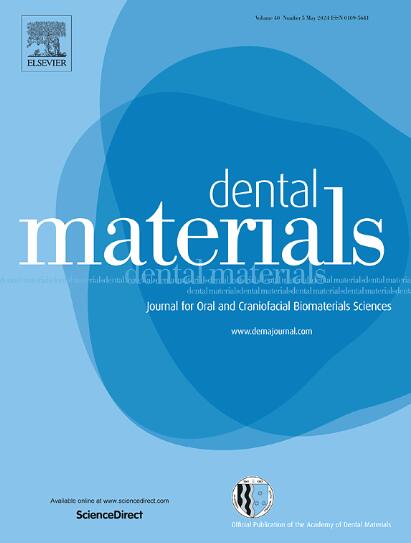Monomer elution and cytotoxicity of 3D-printed resin-based composites
IF 6.3
1区 医学
Q1 DENTISTRY, ORAL SURGERY & MEDICINE
引用次数: 0
Abstract
Objective
To investigate cytotoxicity and monomer release of 3D-printed resin-based composites (RBCs) for both provisional and permanent intraoral use and the influence of post-processing on biocompatibility.
Methods
Cylindrical specimens (10 mm diameter and 1 mm thickness) were prepared from three 3D-printed RBCs and a direct restorative RBC (reference). The specimens were divided into two groups: post-processed (PP) and non-post-processed (NPP) and were immersed in a DMEM cell culture medium for 24 h. The cytotoxicity of the eluates was tested by LDH and XTT assays, and the effect on cell cycle distribution was analyzed by flow cytometry. The degree of conversion was assessed up to 7 days, and the elution of monomers (BisEMA3, BisEMA6, BisEMA10, BisGMA, TEGDMA, and UDMA) was measured up to 7 days in water and ethanol using UHPLC-MS/MS.
Results
The eluates of 3D-printed RBCs did not cause cytotoxicity and no effect on cell cycle distribution was observed. Furthermore, the PP group exhibited a significantly higher DC than the NPP group and the direct composite. In ethanol, the PP group released lower quantities of monomers than the NPP group and the direct RBC.
Significance
Post-processed 3D-printed RBCs exhibited better biocompatibility than direct RBCs in terms of monomer release. Irrespective of post-processing, the amounts of monomers released from the tested RBCs was too low to elicit in-vitro cytotoxicity. However, thanks to the extra-oral post-processing steps, 3D-printed RBCs reached higher DC and released lower quantities of monomers than the direct RBC, which may be relevant for patients with allergic predisposition.
3d打印树脂基复合材料的单体洗脱和细胞毒性。
目的:研究3d打印树脂基复合材料(rbc)的细胞毒性和单体释放情况,以及后处理对其生物相容性的影响。方法:用3个3d打印红细胞和1个直接修复红细胞(参考)制备圆柱形标本(直径10 mm,厚度1 mm)。将标本分为后处理组(PP)和未后处理组(NPP),浸泡在DMEM细胞培养液中24 h。用LDH和XTT法检测洗脱液的细胞毒性,用流式细胞术分析对细胞周期分布的影响。在7天内评估转化程度,并使用UHPLC-MS/MS在水和乙醇中测量单体(BisEMA3, BisEMA6, BisEMA10, BisGMA, TEGDMA和UDMA)的洗脱时间长达7天。结果:3d打印红细胞洗脱液不产生细胞毒性,对细胞周期分布无影响。PP组的DC显著高于NPP组和直接复合组。在乙醇中,PP组释放的单体数量低于NPP组和直接RBC。意义:后处理的3d打印红细胞在单体释放方面表现出比直接红细胞更好的生物相容性。无论后处理如何,从测试的红细胞中释放的单体数量过低,不会引起体外细胞毒性。然而,由于口服后处理步骤,3d打印的红细胞比直接红细胞达到更高的DC,释放的单体数量更少,这可能与过敏易感性患者有关。
本文章由计算机程序翻译,如有差异,请以英文原文为准。
求助全文
约1分钟内获得全文
求助全文
来源期刊

Dental Materials
工程技术-材料科学:生物材料
CiteScore
9.80
自引率
10.00%
发文量
290
审稿时长
67 days
期刊介绍:
Dental Materials publishes original research, review articles, and short communications.
Academy of Dental Materials members click here to register for free access to Dental Materials online.
The principal aim of Dental Materials is to promote rapid communication of scientific information between academia, industry, and the dental practitioner. Original Manuscripts on clinical and laboratory research of basic and applied character which focus on the properties or performance of dental materials or the reaction of host tissues to materials are given priority publication. Other acceptable topics include application technology in clinical dentistry and dental laboratory technology.
Comprehensive reviews and editorial commentaries on pertinent subjects will be considered.
 求助内容:
求助内容: 应助结果提醒方式:
应助结果提醒方式:


